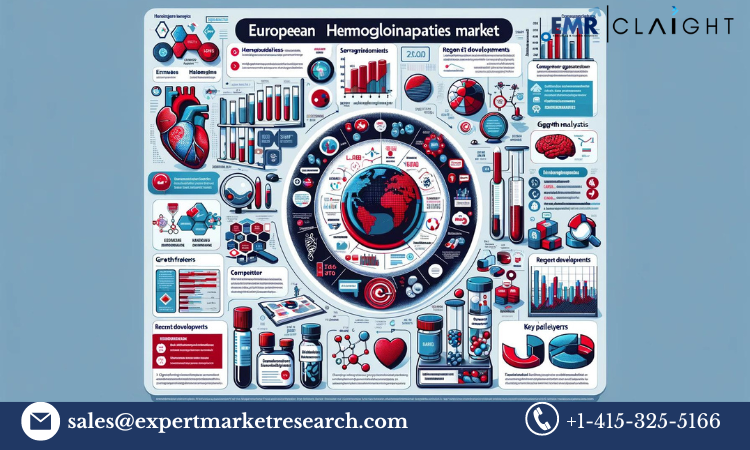The Europe Hemoglobinopathies Market is at the forefront of advancements in the treatment and management of genetic blood disorders such as sickle cell anemia and thalassemia. With Europe holding a significant share of the global market—valued at USD 6.9 billion in 2023—the region is witnessing a surge in research investments, government initiatives, and collaborations that are propelling the market forward. Projected to grow at a CAGR of 9.7% from 2024 to 2032, the Europe Hemoglobinopathies Market is expected to reach USD 15.9 billion by 2032. Below, we explore the key trends and developments shaping this market.
1. Investment in Research and Development
- The Europe Hemoglobinopathies Market is driven by substantial investments in research and development. Governments and private entities alike are allocating significant resources to advance treatment options, particularly in the field of gene therapy. For instance, the Horizon Europe program, the EU’s primary funding program for research and innovation, has dedicated grants to research initiatives that aim to combat genetic disorders.
- Leading pharmaceutical companies, including Novartis AG, Bio-Rad Laboratories, Inc., and Sanofi, have invested heavily in Europe. These companies are partnering with research institutions to develop gene-editing therapies, cell-based treatments, and innovative diagnostic tools. Such advancements have the potential to transform the Europe Hemoglobinopathies Market by offering patients curative treatments rather than lifelong symptom management.
2. Focus on Partnerships and Collaborations
- Strategic partnerships and collaborations are key drivers in the Europe Hemoglobinopathies Market. Pharmaceutical companies, biotechnology firms, and academic institutions are pooling resources and expertise to accelerate the development of innovative therapies. For example, Bristol-Myers Squibb has teamed up with European universities to conduct clinical trials focusing on gene therapies for hemoglobinopathies. This collaboration aims to bring cutting-edge treatments to market faster and enhance therapeutic options for patients.
- Collaborations extend beyond private enterprises, with government bodies and international organizations also playing a crucial role. The Thalassaemia International Federation partners with European governments and healthcare providers to improve patient care standards and promote research initiatives. These partnerships are essential for advancing the Europe Hemoglobinopathies Market, as they provide the infrastructure and funding needed to push new therapies from research to clinical practice.
3. Regulatory Support for Gene and Cell Therapies
- The regulatory framework in Europe is robust, with the European Medicines Agency (EMA) playing a vital role in approving and overseeing the use of gene and cell therapies within the Europe Hemoglobinopathies Market. The EMA’s stringent guidelines ensure that therapies are safe and effective, providing patients with confidence in the treatments they receive. However, these regulations also present challenges for companies, as they must meet rigorous standards before bringing new therapies to market.
- Despite the challenges, the EMA has shown support for innovative treatments by expediting approval processes for certain breakthrough therapies. For example, bluebird bio’s gene therapy for beta-thalassemia received conditional approval from the EMA, reflecting Europe’s commitment to addressing unmet needs in the hemoglobinopathies field. Such regulatory support not only fosters innovation but also enhances the overall growth potential of the Europe Hemoglobinopathies Market.
4. Rising Demand for Early Diagnosis and Screening
- Early diagnosis is critical for effective management of hemoglobinopathies. Many European countries, such as the UK, France, and Italy, have implemented newborn screening programs to detect conditions like sickle cell anemia and thalassemia at birth. The UK National Health Service (NHS), for instance, screens all newborns for sickle cell disease, enabling early intervention and better management of the disorder.
- Prenatal testing is also gaining traction in the Europe Hemoglobinopathies Market. Non-invasive prenatal testing (NIPT) allows for the early detection of genetic disorders, which can be essential for making informed healthcare decisions. European countries are increasingly investing in diagnostic technologies, improving the accessibility and accuracy of genetic testing. The integration of AI and big data in diagnostics is an emerging trend, with several European companies leveraging these technologies to enhance early detection and treatment planning for hemoglobinopathies.
5. Growing Adoption of Personalized Medicine
- The move toward personalized medicine is transforming the Europe Hemoglobinopathies Market. With advancements in genomic testing, healthcare providers can now tailor treatments to individual patients’ genetic profiles, improving treatment efficacy and minimizing side effects. Personalized medicine is particularly valuable for hemoglobinopathies, as it allows for precise interventions based on a patient’s specific genetic mutations.
- This trend is supported by significant investments in technology and data analytics. For example, companies like Novartis and Biogen are utilizing AI-driven data analysis to identify patient-specific treatment pathways. By tailoring treatments, healthcare providers can better address the unique needs of each patient, increasing the effectiveness of therapies and enhancing patient outcomes. As Europe continues to lead in this area, the personalized medicine approach will likely remain a core component of the Europe Hemoglobinopathies Market.
6. Emerging Trends in Gene Editing and CRISPR-based Therapies
- Gene editing technologies, particularly CRISPR, are revolutionizing the Europe Hemoglobinopathies Market. CRISPR allows scientists to edit genes precisely, offering the potential for curative treatments for genetic disorders like sickle cell anemia and beta-thalassemia. Europe has been a leader in adopting these cutting-edge technologies, with several clinical trials underway to explore the safety and efficacy of CRISPR-based therapies.
- The interest in gene editing is reflected in the increased funding for CRISPR research within Europe. Governments and private investors are backing clinical trials and pilot projects, paving the way for the adoption of gene-editing therapies across the continent. As these therapies advance through regulatory approval, they have the potential to significantly impact the Europe Hemoglobinopathies Market by providing patients with curative options that were previously unavailable.
7. The Role of AI and Big Data in Diagnostics
- Artificial intelligence and big data are reshaping the Europe Hemoglobinopathies Market by improving the accuracy and speed of diagnostics. AI algorithms can analyze vast datasets to identify patterns and predict outcomes, making them invaluable tools for diagnosing hemoglobinopathies. European startups and established healthcare companies alike are incorporating AI into their diagnostic platforms, enhancing the ability of healthcare providers to detect these genetic disorders early on.
- By leveraging big data, healthcare providers can monitor patient progress and adjust treatments in real-time, offering a level of personalized care that was previously unattainable. As these technologies continue to evolve, the Europe Hemoglobinopathies Market is likely to see even more advanced diagnostic tools that empower healthcare providers to deliver targeted and effective treatments.
Opportunities and Future Prospects
- The Europe Hemoglobinopathies Market is poised for continued growth, with opportunities emerging in personalized medicine, gene editing, and advanced diagnostics. Expansion into underpenetrated regions within Europe, particularly Eastern European countries, represents a significant opportunity for market growth. Additionally, policy support from the European Union for rare disease research will likely drive further advancements in the hemoglobinopathies field.
- Public-private partnerships will play a critical role in the future of the Europe Hemoglobinopathies Market. These collaborations foster innovation and provide the funding necessary to bring groundbreaking therapies to patients. As Europe continues to invest in healthcare infrastructure and support scientific research, the market’s growth trajectory appears promising, with the potential to improve outcomes for patients across the continent.
















Leave a Reply